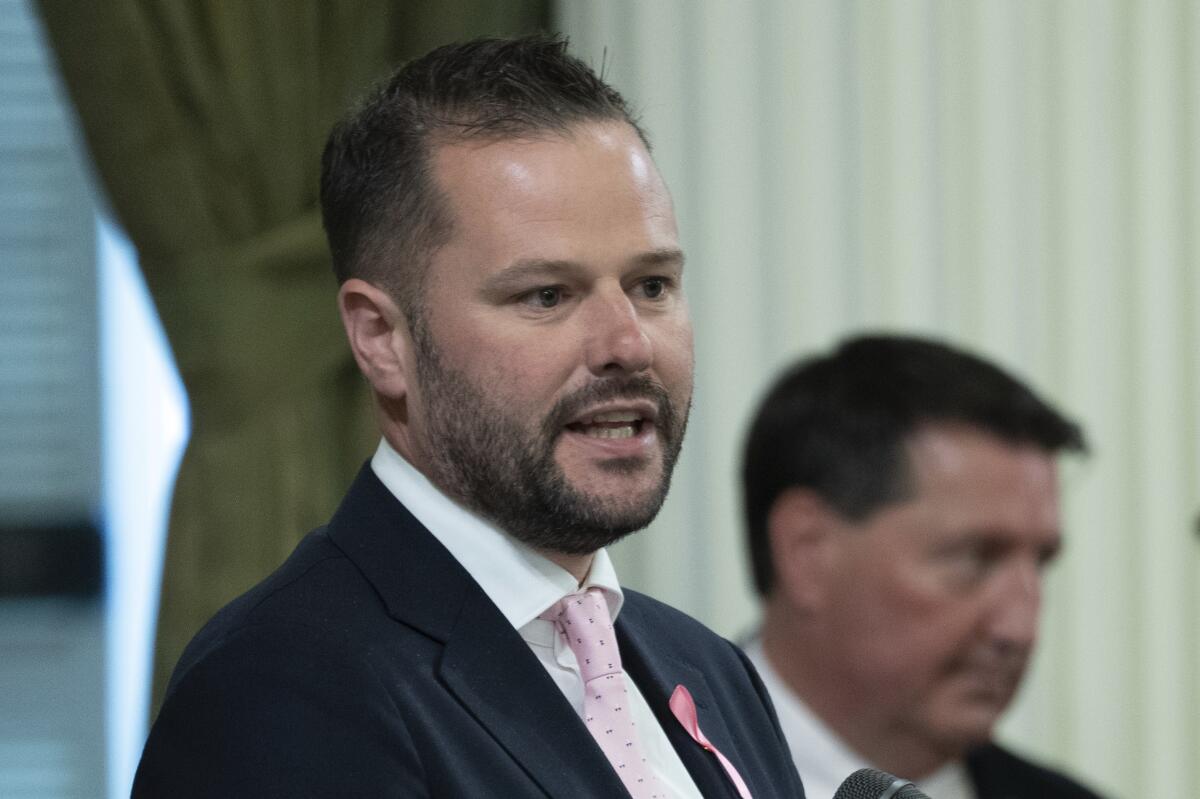A new push to bring recovery homes into state’s ‘housing first’ homeless model

- Share via
After a long journey of personal recovery and years volunteering as a substance abuse peer counselor, Thea Golden launched her own recovery home.
She and her husband, Tyler, bought a house in the Jefferson Park neighborhood west of USC, turned an illegally converted garage into a permitted ADU, formed a nonprofit and put out word through their unofficial social services network that they had two beds for women seeking a sober environment.
Her tiny program, LA Recovery Connect, opened in 2021. Since then, five enrollees have lived in the unit behind their home and moved on to their own housing — two reunited with family and three into their own homes paying their own way.
Now Golden wants to buy or lease another house and add four or five more beds. But even though she’s housing people who would otherwise be homeless, Golden has no access to the hundreds of millions of dollars California hands out each year to do exactly that.
A 2016 law adopting the “housing first” model as state policy prohibits state homelessness money from being spent on programs that are based in abstinence. The rationale is that there should be no condition, such as religious indoctrination or required sobriety, on a homeless person receiving housing.
That could change this year as even some of the strongest proponents of housing first are rethinking that rigid restriction, amid growing evidence that a large share of homeless people would prefer to live in a sober environment.

“When we passed our ‘housing first’ law we were so intent on reducing barriers to addicts that we inadvertently created new barriers to addicts who wanted to get sober,” said Adrian Covert, senior vice president of policy at the Bay Area Council.
Assemblyman Matt Haney (D-San Francisco), who supports the state’s “housing first” policy, is now pushing legislation that would amend it to allow funding of sober living homes. The bill, AB 255, would authorize local jurisdictions to channel up to a fourth of their state homelessness funds to residential programs that practice sobriety. An earlier version in the last legislative session died in the Appropriations Committee. Haney has made changes to quell opposition, and the new bill has passed through the Assembly’s housing and health committees. It’s now in Appropriations.
“If somebody wants to get off of a deadly, dangerous drug like fentanyl, they often need to be as far away from it as possible, and yet the state currently prohibits any of our funding to go towards effective, proven models of drug-free recovery housing,” Haney said in an interview. “It’s counterproductive. It’s wrong. For many people it’s dangerous.”

Debate over the bill revolves around the perceived incompatibility of “recovery” housing that requires residents to maintain sobriety with the “harm reduction” policy that “recognizes drug and alcohol use and addiction as a part of tenants’ lives,” as defined in current law.
In a 2015 policy brief, the U.S. Department of Housing and Urban Development advised that recovery housing “can fulfill a unique and specific role within a community’s homelessness services and behavioral healthcare systems.”
California went the other way, however, adopting SB 1380, written by then-state Sen. Holly Mitchell, which required housing programs to follow the principle that “housing should not be denied to anyone, even if they are abusing alcohol or other substances.”
For providers of recovery housing like Golden, that effectively closed the door to state funding such as the multibillion-dollar Homeless Housing, Assistance and Prevention program.
The Haney bill is responding to growing support for a counter-argument that, as currently practiced, harm reduction is actually harmful for people seeking sobriety by forcing them into housing where drugs and alcohol are used.
“We’re trying to break the cycle of relapse for people in recovery,” Salvation Army recovery advocate Tom Wolf told the Assembly Health Committee in an April hearing. “People exit treatment after a 90-day Medi-Cal program and they get placed into an SRO where everybody around them is still using drugs. If you’re trying to be clean and sober in that environment back in that same neighborhood in Skid Row or the Tenderloin, it’s next to impossible.”
Proponents of the bill cite recent surveys showing a strong connection of substance use with homelessness and a preference of more than a third of unsheltered homeless people for abstinence-based housing.
There is no organized opposition to Haney’s bill, which he’s amended to reconcile the two philosophical positions. It requires a harm reduction option to be available to anyone offered recovery housing. Relapse cannot not be a cause for eviction, and the provider must assist a tenant who wishes to leave the program in finding alternate housing following principles where abstinence is not required.

Housing California, an advocacy group that backs housing first, is not currently opposing the bill but still has objections that it hopes can be worked out in the state Senate, said policy director Christopher Martin.
“We do think there is a place for sober living,” Martin said. “We want to make sure it is not abused.”
Martin said Housing California is concerned that the bill could direct too much money to recovery homes and will try to get the 25% limit reduced to 10%.
Haney said that he negotiated that threshold with homeless services providers but that he is still open to discussing any objections.
There’s also concern about chronic complaints about bad operators who abuse insurance or summarily evict residents who relapse.
“There are a ton of great providers out there that follow great practices,” Martin said. “We have to protect against the worst behaviors.”
In four lawsuits against a network of for-profit recovery homes, attorney Karen Gold alleges that her clients were transported to California from other states, stashed in poorly supervised homes and then put on the street when their insurance ran out.
“From my standpoint, any level of care is only as good as they are regulated,” Gold said. “The more any level of care is regulated, the better results you are going to get.”
The bill requires the state Department of Health Care Services to establish certification of recovery homes and adopt standards. It specifies that those could come from of a private association, the National Alliance for Recovery Residences, a government agency, the Substance Abuse and Mental Health Services Administration, or another, unspecified, group.
While the two sides are working out their policy disagreements, practical implications for small-scale providers such as Golden remain up in the air.
Golden said said she follows the guidelines of another group, the California Consortium for Addiction Programs and Professional, but has not sought certification.

She’s not sure how her policy on relapses fits in. It’s a complex issue. Relapse is generally accepted as a natural part of recovery. A first relapse would be handled through peer counseling. A second would probably lead to a referral to outpatient treatment and a third to a residential treatment program with the bed held for the resident’s return.
Golden said she would try to find alternate housing for someone who gives up on abstinence. She hasn’t had to yet but can see the possibility.
“This is a hard space to step into when you get into the nitty-gritty and it’s the daily routine and we keep that structure and we have a curfew,” Golden said. “If this isn’t a fit for you, let’s get you into the next step.”
With no access to the formal housing system it could be problematic. So far, Golden’s residents who graduated have found new homes through her informal recovery network. Another option she hasn’t had to use yet is SHARE!, a Culver City-based nonprofit where she received her peer counselor training and volunteered. SHARE! supports recovery meetings across the county and leases about 40 single-family homes that provide low-cost housing in shared bedrooms with peer counseling support.
SHARE! worked with Haney on his first bill and hopes to gain access to state funding, said Jason Robison, director of advocacy, business development and training.
But it isn’t clear if its shared-bedroom model would be consistent with language in the law requiring state-funded housing to “ensure individual rights of privacy, dignity and respect.”
“Sharing bedrooms is an essential component” for both types of housing at SHARE!, Robinson said. “In the abstinence-based models, if someone relapses, they are far more likely to overdose and die if they have their own bedroom.”
He said the homes maximize privacy with outdoor seating, family rooms, dens and home offices “so that people can choose to be by themselves or with other individuals when they are outside of their bedrooms.”
For Golden, and hundreds of other small recovery programs, there is no direct path to obtain state money. The bill authorizes local agencies to fund recovery housing. That money is distributed through bidding and generally goes to large nonprofits such as PATH and the People Concern.
Covert, of the Bay Area Council, thinks that to the extent local agencies choose to invest in recovery homes it would be to expand the supply with new construction.
“I would be surprised if a significant amount of money went toward programs currently providing services,” Covert said.
Even if she never obtains direct financial support, Golden still sees benefit in the policy change.
“I’m an advocate for opening up services to people and if it’s not us — I want it to be — but if it’s not, I’m still here to be an advocate for that to open up to other places that I know it would help.”
More to Read
Sign up for Essential California
The most important California stories and recommendations in your inbox every morning.
You may occasionally receive promotional content from the Los Angeles Times.











